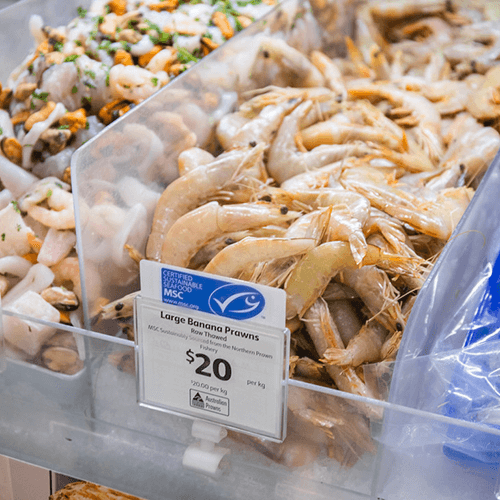This guide aims to give you an overview of what to expect from the Chain of Custody certification process.
Which businesses need certification?
Any seafood sold with the MSC blue fish tick needs to be traceable from ocean to plate. For this to work, every company along the supply chain needs to be certified to the MSC Chain of Custody Standard. The Standard ensures an unbroken chain where certified seafood is identifiable, segregated and traceable.
If your company takes ownership of MSC certified seafood products and wants to sell them as certified, you need Chain of Custody certification.
If your company wants to sell certified seafood to consumers you will also need to apply to use the MSC label.
What is the MSC Chain of Custody?
Who doesn’t need certification?
There are exceptions. You do not require MSC Chain of Custody certification if you:
- Buy pre-packed certified products that will be sold to the end consumer without being opened, re-packed or re-labelled (consumer-ready tamper-proof products)
- Buy certified products but do not wish to sell them as MSC certified. In this case the chain is broken and your customers may not make any claim about the product being MSC certified.
Who assesses my business?
Assessments are conducted by accredited independent certifiers - Conformity Assessment Bodies (CABs).
Full list of CABs for MSC assessments.
What will be assessed?
Certifiers will audit your business to ensure
- You are purchasing MSC certified product from a certified supplier
- Certified products are clearly identifiable
- Certified products are separated from non-certified
- Certified products are traceable and volumes are recorded
- You have a good management system in place
How long? How much does it cost?
The time and cost of your assessment will vary depending on the complexity and size of your organisation as well as your certifier's rates and travel expenses.
We recommend that you get quotes from more than one accredited certifier.
Preparing well for your audit can also help to reduce time and costs.
What else do I need to know?
The MSC Chain of Custody Standard includes different requirements to meet the needs of different types of business.
There are three versions of the Standard and we provide guides for each. If you're unsure, your certifier or a member of MSC staff can help you decide which version is best for your business.
Default Chain of Custody
Default Chain of Custody is for companies operating in one or a few locations.
Examples of businesses that are eligible for Default certification:
- A fishmonger serving final consumers and caterers with the majority of sales by volume and value going to the catering trade
- A seafood company with a trading office, processing facility and storage unit
Group Chain of Custody
Group Chain of Custody is for businesses with a central office function and many locations distributing, processing or trading MSC certified seafood.
Examples of businesses that are eligible for Group certification:
- A co-operative with distribution centres in multiple locations
- A trans-national seafood processing company with multiple sites
- A company whose central office sets requirements for operations at multiple sites or franchises
- A group of independent companies at the end of supply chain, e.g. restaurants or fish mongers, with a group certification manager
Consumer-Facing Organisation Chain of Custody
Consumer-Facing Organisation Chain of Custody is for most businesses selling direct to consumers.
Examples of businesses that are eligible for Consumer-Facing Organisation certification:
- Retailers
- Restaurants
- Caterers
- Fresh fish counters
Businesses with more than one site can be certified to this version of the Standard if all of the following apply:
- All sites are under the control of the same management system, maintained by your company’s head office
- Your head office has an ownership or franchise relationship with each site, or a temporary right to manage all sites and staff
- Your head office controls seafood purchases, ensuring all sites can only order seafood from certified suppliers
Watch our videos on Chain of Custody Certification program for restaurants and for fresh fish counters.
What happens after certification?
Your certification lasts for three years. During this time you will have regular surveillance audits.
Surveillance audits
Audits are usually once a year, but the frequency depends on the version of the Standard your company is certified to. The process is similar to your initial assessment. An auditor will check you're maintaining the correct procedures to identify, segregate, control, manage and trace MSC certified seafood.
Some certifiers offer combined audits with other programs, so you may be able to schedule an MSC audit with another.
There is a small chance that your company will receive an unannounced audit. Each certifier must conduct unannounced audits for at least 1% of their clients.
How can my business use the MSC label?
To use the label you will also require an ecolabel licence agreement.
Upon certification, your business will receive a certificate and a Chain of Custody code. With this code you can apply to use the blue MSC label.
Where can my business buy certified products?
You can find suppliers around the world with MSC Chain of Custody certificates using our Find a supplier directory
We're here to help
We have commercial outreach colleagues around the world who can help with getting your business certified to sell fish and seafood with the blue MSC label.Find your local MSC commercial representative
Find out more

Contact your local MSC commercial representative
We have commercial outreach colleagues around the world who can help with getting your business certified to sell fish and seafood with the MSC blue fish tick label.
.tmb-medium500.jpg?Culture=en&sfvrsn=9f5c49cc_1)
After certification: Resources
When you have Chain of Custody certification you're part of a global network of traceable, sustainable seafood supplies.

Use the blue fish tick
Show your customers your fish comes from a sustainable source by using the MSC blue fish tick label. Find out how to show your commitment to certified sustainable seafood.
